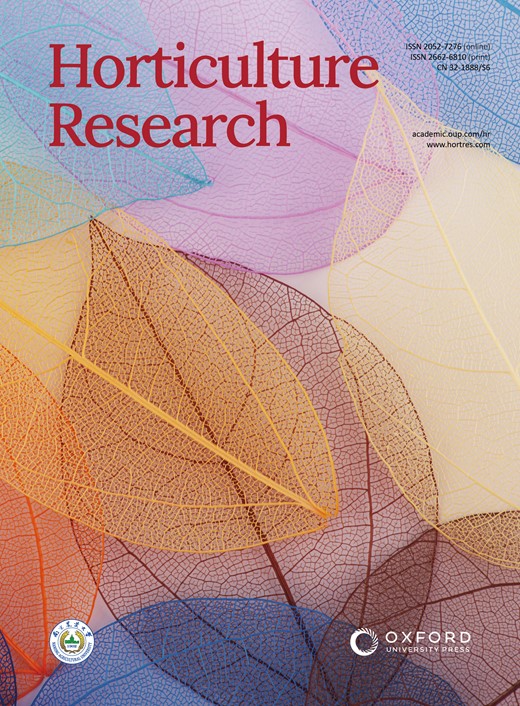CRISPR/Cas9 介导的 CHS2 基因突变导致葡萄孢细胞中的代谢途径从黄酮类转变为二苯乙烯类,从而为白藜芦醇的生物合成提供了新的视角
IF 8.7
1区 农林科学
Q1 Agricultural and Biological Sciences
引用次数: 0
摘要
白藜芦醇是一种重要的植物雌激素,能适应和应对压力条件,在健康和医学疗法中发挥着各种作用。然而,白藜芦醇只存在于数量有限、浓度较低的植物物种中,这阻碍了其开发和利用。查尔酮合成酶(CHS)和二苯乙烯合成酶(STS)催化相同的底物,分别产生类黄酮和白藜芦醇。然而,CHS 和 STS 如何在代谢物合成过程中竞争仍不清楚。本研究利用 CRISPR/Cas9 基因组编辑技术生成了两个 CHS2 突变细胞系(MT1 和 MT2)。这些CHS2突变细胞系中的CHS2发生了大量突变,导致蛋白质翻译过早终止,随后CHS2被敲除。扩增子测序证实了 MT1 中 CHS2 的全面基因敲除,而 MT2 细胞系中仍以野生型序列为主。转录组和 RT-qPCR 结果显示,参与黄酮类化合物生物合成的基因,包括 CHS2、CHS3、F3H、F3'H、DFR、FLS、LDOX 等,都出现了明显的下调,导致花青素、原花青素、槲皮素和山柰醇等黄酮类化合物的积累减少。相反,参与类芪生物合成的 STS 基因上调,与类黄酮途径竞争。因此,在 CHS2 突变体细胞系中,包括白藜芦醇、苦橙皮酚、苦橙皮苷和紫檀芪在内的类橙皮甙显著增加,其中白藜芦醇增加了 4.1 倍,苦橙皮苷(白藜芦醇的衍生物)增加了 5.3 倍。这项研究表明,CHS2 突变会诱导黄酮类生物合成向芪类生物合成转变,为代谢物的生物合成和调控提供了新的视角,也为天然白藜芦醇的生产提供了另一种解决方案,并为利用 CRISPR-Cas9 消除非目标农艺性状提供了一种新的育种方法。本文章由计算机程序翻译,如有差异,请以英文原文为准。
CRISPR/Cas9 mediated CHS2 mutation provides a new insight into resveratrol biosynthesis by causing a metabolic pathway shift from flavonoids to stilbenoids in Vitis davidii cells
Resveratrol is an important phytoalexin that adapts to and responds to stressful conditions, plays various roles in health and medical therapies. However, it is only found in a limited number of plant species in low concentrations, which hinders its development and utilization. Chalcone synthase (CHS) and stilbene synthase (STS) catalyze the same substrates to produce flavonoids and resveratrol, respectively. However, it remains unclear how CHS and STS compete in metabolite synthesis. In this study, two CHS2 mutant cell lines (MT1 and MT2) were generated using CRISPR/Cas9 genome editing. These CHS2 mutant cell lines exhibited abundant mutations in CHS2, leading to the premature termination of protein translation and subsequent CHS2 knockout. Amplicon sequencing confirmed comprehensive CHS2 knockout in MT1, whereas the wild-type sequence remained predominant in the MT2 cell line. Transcriptome and RT-qPCR results showed a significant downregulation of genes involved in flavonoid biosynthesis, including CHS2, CHS3, F3H, F3’H, DFR, FLS, LDOX, among others, resulting in decreased flavonoid accumulation, such as anthocyanins, proanthocyanidins, quercetin, and kaempferol. Conversely, STS genes involved in stilbenoid biosynthesis were upregulated competing with the flavonoid pathway. Consequently, there was a marked increase in stilbenoids, including resveratrol, piceatannol, piceid and pterostilbene, with a 4.1-fold increase in resveratrol and a 5.3-fold increase in piceid (a derivative of resveratrol) observed in CHS2 mutant cell lines. This research demonstrates that CHS2 mutation induces a shift from flavonoid biosynthesis towards stilbenoid biosynthesis, offering new insights into metabolite biosynthesis and regulation, as well as an alternative solution for natural resveratrol production, and a novel breeding approach for eliminating non-target agronomic traits using CRISPR-Cas9.
求助全文
通过发布文献求助,成功后即可免费获取论文全文。
去求助
来源期刊

Horticulture Research
Biochemistry, Genetics and Molecular Biology-Biochemistry
CiteScore
11.20
自引率
6.90%
发文量
367
审稿时长
20 weeks
期刊介绍:
Horticulture Research, an open access journal affiliated with Nanjing Agricultural University, has achieved the prestigious ranking of number one in the Horticulture category of the Journal Citation Reports ™ from Clarivate, 2022. As a leading publication in the field, the journal is dedicated to disseminating original research articles, comprehensive reviews, insightful perspectives, thought-provoking comments, and valuable correspondence articles and letters to the editor. Its scope encompasses all vital aspects of horticultural plants and disciplines, such as biotechnology, breeding, cellular and molecular biology, evolution, genetics, inter-species interactions, physiology, and the origination and domestication of crops.
 求助内容:
求助内容: 应助结果提醒方式:
应助结果提醒方式:


